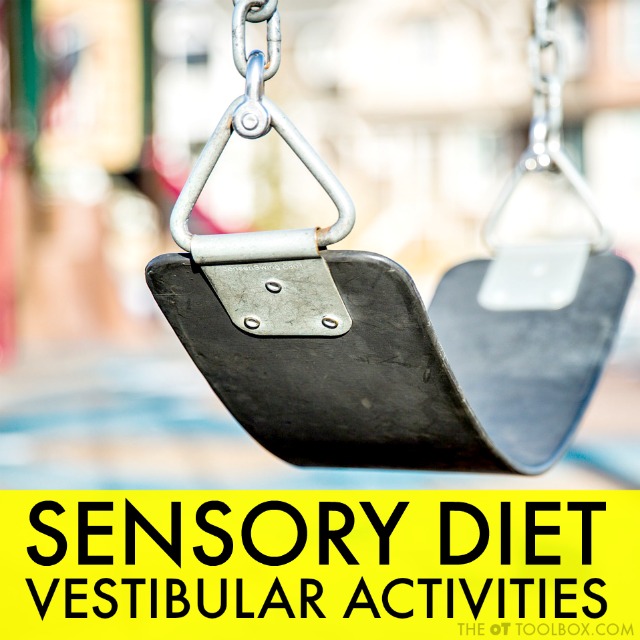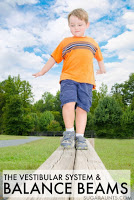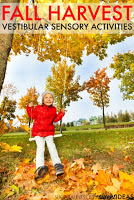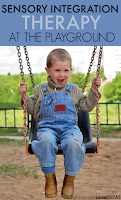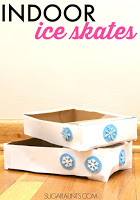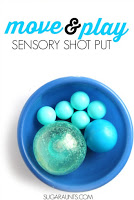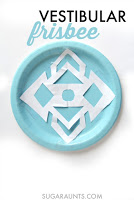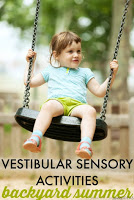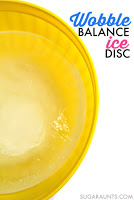The vestibular system is a powerful one! It can be a confusing one when we consider how it impacts our body’s ability to regulate. The vestibular system is one of the three systems that impact all of the others and therefore all learning, cognition, and occupational performance. the vestibular system develops early in life and plays a very important role in early development. for these reasons, today we’re talking about Sensory Diet Vestibular Activities. These are vestibular activities that can be used in a sensory diet and a sensory lifestyle full of meaningful sensory activities. The vestibular activities listed below are those that impact an individual in many ways.
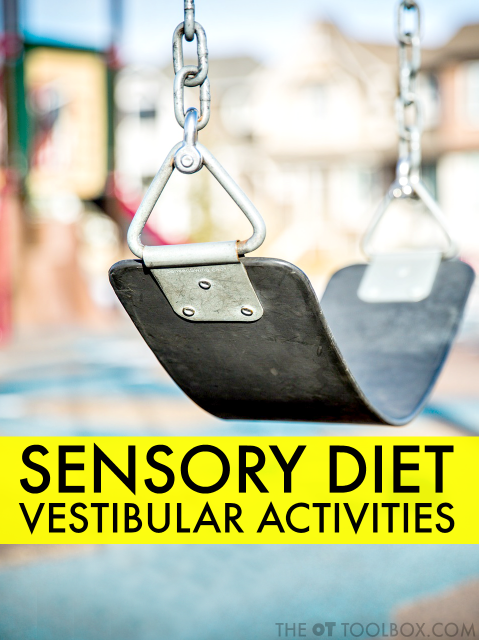
The Vestibular System
Understanding the vestibular system can help explain how and why we need to incorporate vestibular activities into our daily life.
Here is an explanation of the vestibular system from a neurological focus.
Here are vestibular red flags indicating a problem with the vestibular system and how that looks in a child’s day.
Check out those two links above to get a good background on the vestibular system and how it impacts every activity and function that we perform. In fact, the vestibular system plays a huge part in coordination of our head movements with the stimulation in the environment.
+ We are then able to copy words and phrases from the board in the classroom by shifting our vision from the table surface to the overhead board without losing our place.
+ We are able to watch a moving object like a soccer ball as it travels across a field.
+ We are able to read a speech while looking up at our audience, without losing our place on the cue cards.
+ We are able to hold our body in a specific position such as a downward dog yoga position while concentrating on deep breathing.
+ We are able to maintain our head positioning while cutting with scissors or while riding a bicycle.
The vestibular system plays such a huge part in our daily tasks in a manner that happens naturally and without effort!
It is easy to see how a problem with the vestibular system could result in major issues with functioning!
Sensory Diet Vestibular Activities
The sensory vestibular activities listed below are playful ways to promote performance and tolerance to movement activities. They are also challenges against gravity to help kids with difficulties in equilibrium, balance, self-regulation, and adjusting to typical sensory input. The vestibular system operates through receptors in the inner ear and in conjunction with position in space, input from the eyes, and feedback from muscle and joint receptors, is able to contribute to posture and appropriate response of the visual system to maintain a field of vision. This allows an individual to detect movement and changes in the position of the head and body. Dysfunction in the vestibular system may result in hypersensitivity to movements or hyposensitivity to movements.
providing vestibular input as an intervention strategy for sensory needs,
various movement patterns should be considered. Depending on the individualized
needs of the child, activities can be designed to include movements such as:
Prone swinging
movements
Angular movements
movements
movements
balance
support
in motion
direction
Changes in speed
Vestibular Hyperresponsiveness
Some children may present with vestibular hyperresponsiveness.
This looks like a variety of things in children. As we know, every child is uniquely different. The indicators of sensory hyperresponsiveness listed here are only just a few ways that vestibular hyperresponsiveness may present in kids:
- Overly dizzy with motions
- Resistant to moving activities such as
swings, slides, elevators, or escalators - Fear of unstable surfaces
- Unable to tolerate backward motions
- Unable to tolerate side to side motions
- Illness in moving vehicles
- Avoids swings or slides
- Gets motion sick easily
- Gravitational insecurity
- Challenges with unstable surfaces
- Dislike of moving surfaces
Try adding some of these vestibular activities into a sensory diet or sensory lifestyle. (These are just a FEW activities that can be used by children. Activities can be modified to include all of the movement planes listed above.)
Sensory Diet Vestibular Activities for Hyperresponsiveness:
- Skipping
- Prone activates with arms supporting the upper body at the shoulders and elbows
- Slowly adding activities in the quadruped positioning
- Adding a support for jumping, hopping, balance activities
- Crawling
- Walking
- Sliding
- Rolling
- Being pulled on a blanket or sled (indoor works, too!)
- Throwing bean bags at a target
- Throwing/catching a ball
- Movement obstacle courses
- Wheelbarrow races
Vestibular Hyporesponsiveness
On the flip side, a child can present with hyporesponsiveness of the vestibular system. Hypo-responsiveness of the vestibular sense may present in a child as an under-responsiveness or underreaction to vestibular sensation. This may look like the actions listed below. Remember that every child is different. This list is only a sample of the various ways a child can present when they are impacted by hyporesponsive vestibular system.
- Constant movement including jumping,
spinning, rocking, climbing - Craves movement at fast intervals
- Craves spinning, rocking, or rotary
motions - Poor balance on uneven surfaces
- Constantly fidgeting
- Increased visual attention to spinning
objects or overhead fans - Bolts or runs away in community or group
settings, or when outdoors or in large open areas such as shopping malls - Difficulty maintaining sustained
attention - Impulsive movement
- Constantly getting up and down from desk
in the classroom - Walks around when not supposed to (in the
classroom, during meals, etc.) - Loves to be upside down
Sensory Diet Vestibular Activities for Hyporesponsiveness:
Children with hyporesponsiveness of vestibular input may benefit from a variety of activities. Below are just a jew of these ideas. Try using these sensory diet vestibular activities when addressing hyporesponsiveness of vestibular sensation:
- Therapy ball
- Fidget tools
- Cushion or partially deflated beach ball on the floor under feet at a desk or chair.
- Tie therapy band (TheraBand) or a resistive cord around the legs of a student’s chair for use as a foot fidget
- Provide appropriate play-based opportunities for movement needs (sit and spin toy, see saw toy, rocking chair, trampoline)
- Weave vestibular input throughout the day and prior to fine motor/visual motor activities
- Ensure the feet touch the ground or have support when seated in a chair or on the toilet
Sensory diets and specific sensory input or sensory challenges are a big part of addressing sensory needs of children who struggle with sensory processing issues. Incorporating a schedule of sensory input (sensory diet) into a lifestyle of naturally occuring and meaningful activities is so very valuable for the child with sensory needs. That’s why I’ve worked to create a book on creating an authentic and meaningful sensory lifestyle that addresses sensory needs. You can watch for more information on this book coming very soon. If you would like to be the first to know more about this book (and want to grab some upcoming freebies related to sensory lifestyles and sensory diet activities, sign up here. You’ll be the first to get some awesome tools for addressing sensory needs in motivating and meaningful ways.
